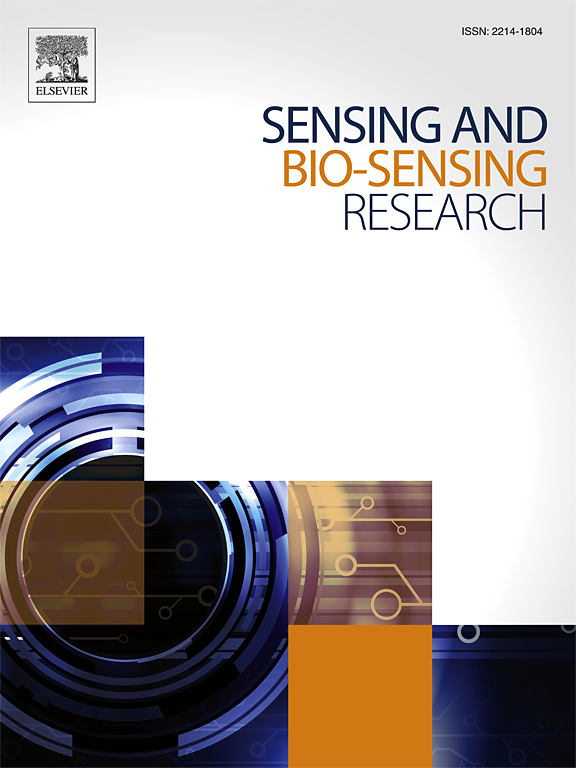基于cqd的电化学免疫传感器检测血栓和COVID-19的d -二聚体
IF 5.4
Q1 CHEMISTRY, ANALYTICAL
引用次数: 0
摘要
血栓形成是心脏病发作、中风和静脉血栓栓塞的主要原因,占全球死亡人数的25%。衰老和不活动等因素会增加静脉血栓栓塞的风险。d -二聚体(DD)水平升高表明肺栓塞和严重的COVID-19等疾病,是血栓检测的关键生物标志物,可预测更高的死亡风险。传统的DD检测方法耗时长,成本高。新兴的点护理(POCT)生物传感器提供了更快、更经济的替代方案,利用电化学或光学检测和纳米结构薄膜。本研究旨在利用碳量子点(CQDs)功能化电极和电化学阻抗谱(EIS)技术开发一种灵敏、无标记的DD检测电化学免疫传感器。CQDs通过提高电导率和提供单克隆抗体(Ab)的锚定位点来提高电极灵敏度。通过KOH活化碳网印刷电极,通过3-氨基丙基三乙氧基硅烷添加氨基,将CQD与1-乙基-3-(3-二甲氨基丙基)碳二亚胺/ n -羟基琥珀酰亚胺(EDC/NHS)连接,并将DD Ab固定在CQD表面,制备出生物传感器。拉曼光谱和EIS证实了Ab和牛血清白蛋白层的成功功能化和抗性增加。该传感器可有效检测DD抗原,校准曲线范围为10 ~ 1000 ng mL−1,低检出限为13.4 ng mL−1。CQDs提高了灵敏度,低Ab浓度降低了成本。这种基于cqd的阻抗免疫传感器为早期血栓形成检测和监测静脉血栓栓塞和COVID-19等疾病提供了一种实用的方法。本文章由计算机程序翻译,如有差异,请以英文原文为准。

CQD-based electrochemical immunosensor for sensitive D-dimer detection in thrombosis and COVID-19
Thrombosis, a leading cause of heart attacks, strokes, and venous thromboembolism (VTE), contributes to 25 % of global deaths. Factors like aging and immobility increase VTE risk. D-dimer (DD), whose elevated levels indicate conditions such as pulmonary embolism and severe COVID-19, is a key biomarker for thrombus detection, predicting higher mortality risks. Traditional DD detection methods are time-consuming and costly. Emerging point-of-care (POCT) biosensors offer faster, cost-effective alternatives, utilizing electrochemical or optical detection and nanostructured films. This study aims to develop a sensitive, label-free electrochemical immunosensor for DD detection using carbon quantum dots (CQDs) functionalized electrodes and electrochemical impedance spectroscopy (EIS). CQDs enhance electrode sensitivity by improving conductivity and providing anchoring sites for monoclonal antibody (Ab). The biosensor was made by activating a carbon screen printed electrode with KOH, adding amino groups via 3-Aminopropyltriethoxysilane, linking CQDs with 1-ethyl-3-(3-dimethylaminopropyl) carbodiimide/N-hydroxysuccinimide (EDC/NHS), and immobilizing DD Ab on CQD surface. Raman spectroscopy and EIS confirmed successful functionalization and increased resistance with Ab and bovine serum albumin layers. The biosensor effectively detected DD antigens, with a calibration curve ranging from 10 to 1000 ng mL−1 and a low limit of detection of 13.4 ng mL−1. CQDs improved sensitivity, and low Ab concentrations reduced costs. This CQD-based impedance immunosensor offers a practical approach for early thrombosis detection and monitoring diseases like VTE and COVID-19 at the point of care.
求助全文
通过发布文献求助,成功后即可免费获取论文全文。
去求助
来源期刊

Sensing and Bio-Sensing Research
Engineering-Electrical and Electronic Engineering
CiteScore
10.70
自引率
3.80%
发文量
68
审稿时长
87 days
期刊介绍:
Sensing and Bio-Sensing Research is an open access journal dedicated to the research, design, development, and application of bio-sensing and sensing technologies. The editors will accept research papers, reviews, field trials, and validation studies that are of significant relevance. These submissions should describe new concepts, enhance understanding of the field, or offer insights into the practical application, manufacturing, and commercialization of bio-sensing and sensing technologies.
The journal covers a wide range of topics, including sensing principles and mechanisms, new materials development for transducers and recognition components, fabrication technology, and various types of sensors such as optical, electrochemical, mass-sensitive, gas, biosensors, and more. It also includes environmental, process control, and biomedical applications, signal processing, chemometrics, optoelectronic, mechanical, thermal, and magnetic sensors, as well as interface electronics. Additionally, it covers sensor systems and applications, µTAS (Micro Total Analysis Systems), development of solid-state devices for transducing physical signals, and analytical devices incorporating biological materials.
 求助内容:
求助内容: 应助结果提醒方式:
应助结果提醒方式:


